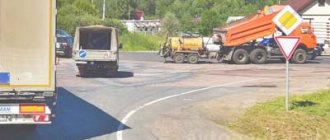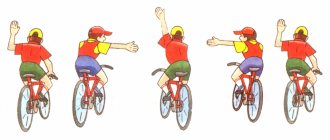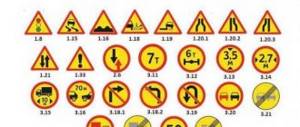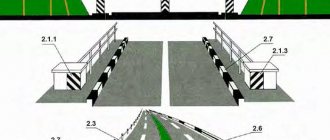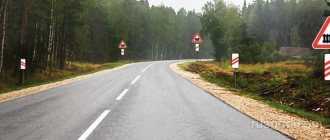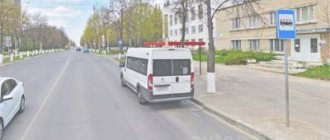Visual traffic control symbols may be installed for a limited period. They differ from stationary ones in appearance, but sometimes drivers confuse the temporary sign with the permanent one located on the yellow-green board. In addition, many are confident that they will not face anything for ignoring the requirements of the current limited-term symbol.
Read about what temporary road signs are, where and how they are installed, as well as the rules they dictate.
Temporary road signs in traffic regulations and their features
The traffic rules stipulate that the following symbols can be valid for a limited period:
- 1.8, notifying that traffic is regulated by a traffic light;
- 1.15, installed on slippery surfaces;
- 1.16, informing about uneven roads;
- 1.18, warning about the release of gravel under the wheels of the car;
- 1.20.1-1.20.3, installed before the narrowing of the web;
- 1.21, notifying about the establishment of two-way traffic;
- 1.25, informing about road works;
- 1.32, indicating that there is a traffic jam on the way;
- 1.33, warning of danger;
- 1.34.1, 1.34.2, indicating the direction of rotation;
- 2.5, prohibiting driving without stopping;
- 2.6, determining the advantage of oncoming traffic;
- 2.7, limiting the scope of the previous pointer;
- 3.20, prohibiting overtaking in the area;
- 3.21, terminating 3.20;
- 3.24, limiting the maximum permitted speed;
- 3.25, completing the zone of influence of the previous symbol;
- 4.2.1-4.2.3, indicating the need to go around an obstacle;
- 6.17, showing the detour scheme;
- 6.18.1-6.18.3, showing the direction in which to avoid the obstacle;
- 6.19.1, 6.19.2, establishing the need to change lanes to another carriageway when the first one is closed to traffic.
But taking into account specific conditions, any designation can be established for a limited period.
According to traffic regulations, temporary road signs are often combined with each other and supplemented with signs that clarify the territory of their influence or indicate the distance to the problem area. Some of them are rare. Others can be seen in populated areas as well as on highways.
We recommend reading about what traffic markings are like on the road. From the article you will learn about the types of markings according to traffic regulations, what markings mean depending on color and application, what to do if the markings are not visible on the road. And here is more information about how to follow the “Main Road” road sign.
When must temporary signs be removed?
The Code of Administrative Offenses and federal laws say nothing about how urgently invalid signs should be removed. Usually, to resolve such situations, they resort to GOST standards. Thus, GOST 33220-2015 specifies the requirements for the condition of highways.
More on the topic: Is it legal to install LED lamps in headlights?
Important! According to clause 4.4 of GOST 33220-2015, 1 day is allotted for dismantling temporary signs (after eliminating the reasons that led to their installation).
In addition to this document, the driver has the right to refer to standard R 50597-2017, which was introduced to replace the outdated GOST 50597-93. GOST R 50597-2017 describes the requirements for roads and streets.
Reference! Clause 6.1.2 states that temporary signs installed in connection with the repair of any roads must be dismantled within 24 hours after completion of the work for which they were installed.
This paragraph also states that after road maintenance work, temporary signs must be removed completely within 1 hour. In any case, if the repairs were completed more than a day ago, and the signs are still on the road, then the actions of the authorities and contractors are completely unlawful.
But GOST standards are not mandatory!
When arguing with traffic police inspectors and judges (if you decide to appeal the fine), the driver may hear that GOSTs are only recommendations and not strict regulations. In reality, this opinion is not substantiated by anything.
Important! Order of the Government of the Russian Federation No. 2438-r (as amended on October 29, 2018) establishes a wide list of various documents that are mandatory for use, since they directly control road safety.
This list mentions the same national standard GOST R 50597-2017, which requires signs to be removed within 24 hours after completion of repairs.
In addition, you can refer to the technical regulation of the Customs Union 014/2011, to which is attached the decision of the Board of the Eurasian Economic Commission No. 159. This decision provides a list of various standards, the requirements of which must be met on a voluntary basis in order to ensure traffic safety. The previously mentioned GOST 33220-2015 is on this list.
More on the topic: Is it possible to drive in reverse on a one-way road?
Finally, paragraph 7 of Article 11 of Federal Law No. 443 “On Traffic Management” directly states that the placement of additional traffic management equipment (not specified in the documentation) is not allowed. Thus, if temporary signs are not reflected in the contractor’s documents, then their use becomes illegal.
What to do with all these regulations? The driver must know that he has the right to go to court if he receives a fine or an administrative decision, the reason for which was a sign that was not removed on time. To confirm your rights, you must refer to the following documents:
- Code of Administrative Offenses of the Russian Federation;
- Federal Law No. 196 “On Road Safety”;
- Order of the Government of the Russian Federation No. 2438-r;
- Technical Regulations of the Customs Union 014/2011;
- Federal Law No. 443 “On the Organization of Road Traffic”.
Reference! In some cases, the court requires documentation from the contractors who carried out the repair work. The submitted documents must indicate the dates of work carried out in the disputed area.
If an offense (speeding) was recorded before one day had passed since the completion of the repairs, then the court may not grant your request. The fact is that the law allows dismantling to be carried out within 24 hours, so claims against the contractor are unlawful.
If the repair work has long been completed, and contractors and road services are in no hurry to remove temporary signs, then the court will definitely rule in your favor. The persons mentioned are directly responsible for the condition of the road and the organization of traffic, so they may be punished. In this case, the driver’s fine (or other order) is automatically removed.
Speed limits
Temporary "Speed Limit" road signs are usually used where repairs are underway, a detour is required, or you have to drive along a narrow section. And driving fast can lead to an accident.
3.24 yellow is often combined with the symbols 3.20, 4.2.1-4.2.3, 1.15,1.16, 1.18 or 1.20.1-1.20.3. Sometimes several speed limit indicators are placed one after another so that cars reduce it smoothly. For example, on the first segment it should be no more than 70 km/h, on the next – up to 50 km/h, on the final – up to 40 km/h.
And next to 3.24 there may be a sign 8.2.1. It shows the length of the section along which you should drive at a limited speed. If it is not there, you should look for symbol 3.25, which completes the area of influence of 3.24.
Installation Rules
The basic rule for installing permanent (temporary) technical components is that the pointer is turned with the front part towards the movement.
When installing devices, take into account:
- Traffic specifics.
- Features of the territory.
- Traffic congestion during the day and at night.
The minimum visibility distance (up to 150m) allows vehicle drivers to make the right decisions in time in accordance with the requirements of the signs.
Also, when installing components that regulate vehicle movement, natural conditions are taken into account: the presence of trees and bushes near the road surface. According to the rules, the devices are installed so that plant branches do not block the view of vehicle drivers.
The main function of signs, regardless of the characteristics of the equipment, is to ensure safety while driving, therefore the main requirement during installation is the validity of the installation.
How are pointers used?
The purpose of the temporary technical traffic control components is:
- Preventing accidents under changing traffic or pedestrian conditions.
- Ensuring transport movement during repair work.
- Guaranteeing the safety of workers involved in road repairs.
Such tasks are solved by installing: signs, traffic control devices and special barriers.
A road work site is usually considered to be a section of the roadway: from the first temporary sign indicating repairs to the symbol canceling the first sign.
If the repair work is short-term in nature and there is no corresponding sign, the end of the repaired section is considered to be the last technical device installed on or along the roadway.
Main groups of temporary road symbols:
- Fencing.
- Pointing.
- Signaling and illuminating.
- Warning.
- Temporary road markings.
In certain conditions, the participation of a traffic controller or traffic light is acceptable.
Technical means used to control vehicle movement must comply with accepted technical standards and approved documentation.
Temporary prohibition signs are installed directly on the road, roadsides or dividing strip. Warning and restrictive signs are mounted on portable rack supports or mobile complexes.
When working on highways with heavy traffic flow or dangerous areas, temporary signs of increased size are used. Depending on the time of day and duration of work, the symbols are supplemented with flashing light elements, and symbols painted on a yellow background with fluorescent paint are used as warning signs.
In accordance with the requirements of GOST, temporary road signs: 1.8, 1.15, 1.16, 1.18-1.21, 1.33, 2.6, 3.11-3.16, 3.18.1-3.25, on a yellow background, are used in road work areas. In this case, similar components, on a white background, are covered or dismantled.
During road works
It is temporary signs during road works that can be found most often. They are almost never permanent, that is, with a white background.
1.25 requires special attention from drivers. In its coverage area there is not only a problem road, but also special equipment, materials and workers. Here it is necessary to reduce the speed, so symbol 3.24 is installed nearby. Crushed stone may fly from the road under the wheels, which will be warned by designation 1.18. And the width of the area left for travel is reduced, so from 1.25 signs 1.20.1-1.20.3 are fixed.
If the section under repair needs to be bypassed, drivers will see symbols 6.17 or 6.18.1-6.18.3. Additional signs (but not plates) must also be yellow.
1.25 has installation features:
Sign 1.25 when carrying out short-term work on the roadway can be installed without sign 8.1.1 at a distance of 10 - 15 m from the work site.
And outside the city or village it is repeated 50 m before the dangerous segment. In populated areas, 1.25 is placed directly in front of the area being repaired.
Portable and yellow
Yellow temporary road signs are often confused with permanent ones located on a rectangular base of the same color. But in the second case, this background is external. Inside, the permanent symbol is white and the main image is drawn on it. And the yellow-green surroundings make it easier to see in the dark.
The temporary indicator has a yellow background inside the border. It contains the main image. Simultaneously with the installation of non-permanent signs, permanent signs must be removed or hidden. But they often remain visible.
A characteristic feature of symbols used for a limited period is the installation method. They can be placed directly on the roadway in the form of a “clamshell”. Portable temporary road signs are easier and faster to install and remove. In addition, several signs can be placed on one folding support at once. The method is legalized by GOST:
In places where work is being carried out on the road and during temporary operational changes in the organization of traffic, signs on portable supports may be installed on the roadway, roadsides and dividing strip.
General provisions
The places where work is carried out on the road are the following areas: roadsides, roadways, bridges, dividing strips, slopes of the roadbed, paths for cyclists and pedestrians and other work that requires changes in the movement of pedestrian flows, bicycles and vehicles.
Before starting work, it is necessary to decide on the passage of cars, bicycles and pedestrians, the order of their movement in areas of road operations for the safety of road users and persons involved in production.
Read on topic: Rules for installing road signs
Work areas are equipped with technical means of organizing traffic on the road, guides and fencing elements.
During the construction of the road, its reconstruction and major repairs, to equip the places where work is being carried out, the following is used:
- temporary roadway markings;
- temporary road signs;
- signaling equipment;
- road devices;
- guiding devices and fencing.
The temporary traffic change location is divided into five zones:
- Warning zone.
- Driving area.
- Next comes the longitudinal buffer zone.
- Work zone.
- Return zone.
The work is carried out in accordance with the established traffic pattern and fencing of the area where road work is being carried out. Failure to comply with the diagram, as well as the use of damaged technical equipment, is unacceptable.
The installation of the required means is carried out before the start of work in the following sequence:
- Road signs.
- Road traffic lights.
- Next comes the road markings.
- Guiding devices.
- Fencing devices.
Validity area of temporary signs
Yellow traffic control symbols are not only limited in terms of their use. The coverage area of temporary road signs is also not endless. It may be limited to:
- Another symbol signifying the end of the territory of influence of the previous one. For example, for a section with a speed limit it is 3.25. The second pointer should also be yellow.
- Table 8.2.1. It shows at what distance the sign attached next to it is valid and is installed with a repeat symbol.
- Tables 8.2.2, 8.2.3. Used less frequently.
- Index 3.31. It means the completion of all restrictions imposed up to this point.
If there are no listed symbols (which is rare), the territory of influence ends at the intersection closest to the installation site or at the beginning (end) of a populated area.
Installation according to GOST
GOST R 52289-2004 requires temporary road signs to be mounted in a special way. In case of poor visibility, they are duplicated on the left side of the track, the dividing strip. Restricted symbols are located at a distance of at least 50 m from each other if we are talking about a section outside a city or village. And in populated areas it should be 25 m.
There are special installation requirements for some signs:
Outside populated areas, signs 1.1, 1.2, 1.9, 1.10, 1.23 and 1.25 are repeated. The second sign is installed at a distance of at least 50 m before the start of the dangerous section. Signs 1.23 and 1.25 are also repeated in populated areas immediately at the beginning of the dangerous section.
There is also this condition:
Signs are installed immediately in front of an intersection, a turnaround point, a service facility, etc., and if necessary, at a distance of no more than 25 m in populated areas and 50 m outside populated areas in front of them, except in cases specified by this standard.
Expert opinion
Nadezhda Smirnova
Automotive Law Expert
That is, some non-permanent symbols are installed directly in front of a difficult section where you need to change the driving mode, while others are also installed several tens of meters before it.
Changes in traffic rules and new fines
Starting from August 6, 2013, amendments were made to the Traffic Rules.
Speed – up to 130 km/h
The maximum speed limit to 130 km/h is indicated by the following sign (Fig. 1).
It is allowed to increase the speed on sections of roads for certain types of vehicles if road conditions provide for safe movement at a higher speed by decision of the owners or owners of highways.
In this case, the permitted speed should not exceed 130 km/h on roads marked with the above sign, and 110 km/h on roads marked with sign 5.3 (Fig. 2).
This is the meaning of the note to paragraph 10.3 of the Traffic Rules, and it applies to roads located outside populated areas.
Please note that increasing the maximum speed to 130 km/h is possible only on highways and solely by the decision of the owners or possessors of the highways. If such a permit is not available, then the speed limit must comply with the general traffic regulations. The presence of such a permit is indicated by a sign limiting the speed to the maximum permitted limit, i.e. up to 130 km/h.
Temporary signs
The following changes have been made to Appendix 1 “Road Signs”.
As it was before: “In cases where the meanings of temporary road signs (on a portable stand) and stationary signs contradict each other, drivers should be guided by the temporary signs.”
How it became: “The yellow background on signs 1.8, 1.15, 1.16, 1.18-1.21, 1.33, 2.6, 3.11-3.16, 3.18.1-3.25, installed at road work sites, means that these signs are temporary.
If the meanings of temporary road signs and permanent road signs contradict each other, drivers should be guided by the temporary signs."
Temporary signs must be placed permanently, without the use of portable supports.
The following twenty-six warning and prohibition signs can now appear on roads with a yellow background (Fig. 3).
Changes in road markings
The change in Appendix 2 “Road Markings” is as follows.
As it was: “In cases where the meanings of road signs, including temporary ones (placed on a portable support), and horizontal marking lines contradict each other or the markings are not sufficiently distinguishable, drivers must be guided by the road signs. In cases where temporary marking lines and permanent marking lines contradict each other, drivers must be guided by the temporary marking lines.”
As it became: “In cases where the meanings of road signs, including temporary ones, and horizontal marking lines contradict each other or the markings are not sufficiently distinguishable, drivers must be guided by the road signs. In cases where temporary marking lines and permanent marking lines contradict each other, drivers must be guided by the temporary marking lines.”
This eliminates the possibility of placing signs on a portable support.
Parking definition
Parking (parking space) is a specially designated and, if necessary, arranged and equipped place, which is, among other things, part of a highway and (or) adjacent to the roadway and (or) sidewalk, roadside, overpass or bridge, or is part of underpass or underbridge spaces , areas and other objects of the road network, buildings, structures or structures and intended for organized parking of vehicles on a paid basis or without charging a fee by decision of the owner or other owner of the highway, the owner of the land plot or the owner of the corresponding part of the building, structure or structure .
Changes in stopping and parking rules
As it was: “...closer than 15 meters from the stopping places of route vehicles, indicated by marking 1.17, and in its absence - from the sign of the stopping place of route vehicles (except for stopping for boarding or disembarking passengers, if this does not interfere with the movement of route vehicles) "
As it became: “...closer than 15 meters from the stopping places of fixed-route vehicles or the parking of passenger taxis, indicated by marking 1.17, and in its absence - from the sign of the stopping place of fixed-route vehicles or the parking of passenger taxis (except for a stop for boarding and disembarking passengers, if this will not interfere with the movement of route vehicles or vehicles used as passenger taxis)” (Fig. 4).
Taxi stops are equivalent to public transport stops. That is, ordinary motorists can use them only for boarding and disembarking passengers.
There is a complete ban on the movement of trucks under sign 3.4.
The description of exceptions for prohibition signs 3.2-3.8 has been changed.
It was like this: “3.2-3.8 - on vehicles of federal postal service organizations that have a white diagonal stripe on a blue background on the side surface, and vehicles that serve enterprises located in the designated area, and also serve citizens or belong to citizens living or working in the designated area. In these cases, vehicles must enter and exit the designated area at the intersection closest to their destination.”
It became: “3.2, 3.3, 3.5-3.8 - for vehicles of federal postal organizations that have a white diagonal stripe on a blue background on the side surface, and vehicles that serve enterprises located in the designated area, and also serve citizens or belong to citizens living or working in the designated area. In these cases, vehicles must enter and exit the designated area at the intersection closest to their destination;
3.4. - on vehicles of federal postal service organizations that have a white diagonal stripe on a blue background on the side surface.”
Consequently, the movement of trucks in the area covered by sign 3.4 is completely prohibited. An exception is made only for a federal postal service vehicle.
New sign
The new sign 5.14.1 “End of lane for route vehicles” looks like this (Fig. 6).
The purpose of its introduction is a more flexible organization of traffic using dedicated lanes for route vehicles.
Changes in signs
Sign 6.4 “Parking area” has been changed. True, outwardly he has not changed. Only its name has changed - 6.4 “Parking (parking space)” (Fig. 7).
New signs have appeared - 8.4.9-8.4.14 “Except for the type of vehicle”, which indicate the type of vehicle that is not covered by the sign (Fig. 8).
Thus, plate 8.4.14 does not apply the sign to vehicles used as passenger taxis.
Plates 8.4.9-8.4.14 allow you to cancel the effect of the sign on a certain type of vehicle. Plate 8.24 “A tow truck is working” (Fig. 9) indicates that a vehicle is being detained in the coverage area of road signs 3.27-3.30.
The use of this plate is similar to the use of plate 8.23 “Photo and video recording”, introduced by amendments to the traffic rules from July 1, 2013.
Let me remind you that starting from July 1, 2013, changes were made to section 8 of appendix 1 to the traffic rules. A new sign was added - 8.23 “Photo and video recording” (Fig. 10), which is used with signs 1.1, 1.2, 1.8, 1.22, 3.1-3.7, 3.18.1, 3.18.2, 3.19, 3.20, 3.22, 3.24, 3.27-3.30 , 5.14, 5.21, 5.27 and 5.31, as well as with traffic lights.
This sign indicates that in the coverage area of the road sign or on a given section of the road, administrative offenses can be recorded using automatic means of special technical means that have the functions of photography, filming and video recording, or by means of photography, filming and video recording.
This is an additional sign that cannot be used without the main signs shown in Fig. eleven.
The description of the plate indicates that photo-video recording may or may not be used.
It’s the same with a tow truck: a tow truck may or may not work within the coverage area of a sign with this plate. And vice versa: a tow truck can work where this sign is missing. There are no rules for using plate 8.24.
Paid services
Initially, sign 8.8 “Paid services” indicated that services are provided only in cash.
Now sign 8.8 “Paid services” (Fig. 12) indicates that services are provided only for a fee. Obviously, this is a formal change due to the fact that it is now possible to use non-cash payment in paid parking lots.
About fines
Starting from September 1, 2013, Federal Law No. 196-FZ dated July 23, 2013 “On Amendments to the Code of the Russian Federation on Administrative Offenses and Article 28 of the Federal Law “On Road Safety”” increases fines for violations.
It has been established that driving a vehicle by a driver who is intoxicated, or transferring control to such a person, or refusing a medical examination will be punishable by a fine of 30,000 rubles. with deprivation of rights for a period of 1.5 to 2 years. Previously, only deprivation of rights for a specified period was provided.
Repeated driving of a vehicle while intoxicated or repeated transfer of control to such a person will entail the imposition of an administrative fine in the amount of 50,000 rubles. with deprivation of rights for three years. Previously - deprivation of rights for a specified period.
Driving a vehicle by a driver who is intoxicated, without or deprived of a license, or such a driver’s refusal to undergo a medical examination will be punishable by administrative arrest for a period of 10 to 15 days.
If arrest cannot be applied to a person, then a fine of 30,000 rubles will be applied. Previously, arrest of up to 15 days and a fine of up to 5,000 rubles were provided.
“Zero ppm” is excluded, i.e. liability for the offenses described above occurs only when a concentration of absolute ethyl alcohol is detected in excess of 0.16 mg per liter of exhaled air or narcotic drugs or psychotropic substances in the human body.
Fines for almost all other traffic violations have been increased.
For example, talking on the phone while driving will cost 1,500 rubles. (previously - 300 rubles).
Repeated, i.e., committed within a year after the decision on imposing an administrative penalty comes into force, driving through a red traffic light will “cost” 5,000 rubles. or deprivation of rights for a period of 4 to 6 months. Previously, there was no provision for liability for such actions.
The fine for exceeding the established speed by more than 20, but not more than 40 km/h will be 500 rubles. (previously - 300 rubles).
Attention: penalties for speeding by 20 km/h or less are excluded!
Exceeding the speed limit by more than 80 km/h will be punishable by a fine of 5,000 rubles. or deprivation of the right to drive transport for 6 months. Repeated violation of the speed limit by more than 60 or 80 km/h will result in license deprivation for 1 year.
If an offense is detected by automatic technical means, the fine will be 5,000 rubles.
IMPORTANT:
In short, on some sections of the road you can drive at a maximum speed of 130 km/h. Temporary signs are now highlighted with a yellow background. The term “parking” is defined in the traffic regulations.
Taxi stops are equivalent to public transport stops. That is, ordinary motorists can use them only for boarding and disembarking passengers.
The movement of trucks in the area covered by sign 3.4 is completely prohibited. An exception is made only for a federal postal service vehicle.
“Zero ppm” is excluded, i.e. liability for the offenses described above occurs only when a concentration of absolute ethyl alcohol is detected in excess of 0.16 mg per liter of exhaled air or narcotic drugs or psychotropic substances in the human body.
Penalties for speeding by 20 km/h or less are excluded.
Stanislav GOROD, lawyer
Travel fine
The fine for temporary road signs, or rather driving under them not according to the rules, can be at least 500 rubles. There is part 1 of article 12.16 of the Administrative Code. But if the driver turned left or turned around the wrong way, stopped or parked, he will give 1000-1500 rubles.
We recommend reading about what road safety means. From the article you will learn about the road safety management organization responsible for its implementation. Here's more about the main warning signs.
Temporary road signs are a common cause of penalties. Because of them, it is difficult to change the usual driving habits on a well-known section of the road. And yet you will have to do this, because now you can be fined for a violation even if it is recorded by a video camera.
Legality of fines for failure to remove temporary signs
Reference! Article 12.9 of the Code of Administrative Offenses of the Russian Federation establishes sanctions for speeding (administrative fines or deprivation of a driver’s license).
When imposing a fine, traffic police officers refer specifically to this article, however, in the case of temporary signs that have not been removed, it is necessary to carefully understand the specific offense. According to the Administrative Code, any offense is considered from the point of view of established regulations. If the order is incorrect or subject to cancellation, then the misdemeanor cannot be considered an offense. In our case, the temporary sign loses its purpose after the repair is completed, and therefore cannot serve as a basis for imposing a fine.
Important! Article 24.5 of the Code of Administrative Offenses directly states the circumstances according to which no one has the right to make any decisions on a specific offense.
Thus, the consideration of administrative offenses must be terminated in the following cases:
- if there is no event of an offense;
- if there is no corpus delicti.
When translated from legal language into Russian, it turns out that the event of the offense is still present: the driver drove at a speed that is prohibited by a temporary sign. To determine whether an offense is present, its components should be determined:
- Object – certain relations or phenomena that are regulated and protected by regulations (including the Code of Administrative Offenses). In our situation, the object is understood as road safety.
- The objective side is the signs according to which it is possible to establish the fact of an offense, identify the result of the offense, the cause-and-effect relationship, motives and other circumstances.
- Subject – the person committing the offense (driver).
- The subjective side is the degree of guilt of the driver (the offense can be committed intentionally or through negligence).
More on the topic: How to restore a vehicle registration certificate if lost
If you study all these 4 components of the offense, you will find that the object of the offense does not exist. Temporary signs are installed in connection with repairs, as the condition of the roadway is deteriorating, and this entails an increased risk of accidents. After the repair, the danger of losing control disappears, and the left sign does not affect the road situation at all.
Attention! If the road repair is completed, then the object of the offense disappears, thus, if the specified speed is exceeded, the driver does not commit any offenses.
When considering a specific case, traffic police officers are required to prove all the components of the offense (except for the subject, since he initially appears in the case as a violator). The resolution usually indicates the phrase “Found guilty,” which is a sign of the subjective side. The object and objective side of the offense do not exist in this case, therefore the driver cannot be held accountable.
